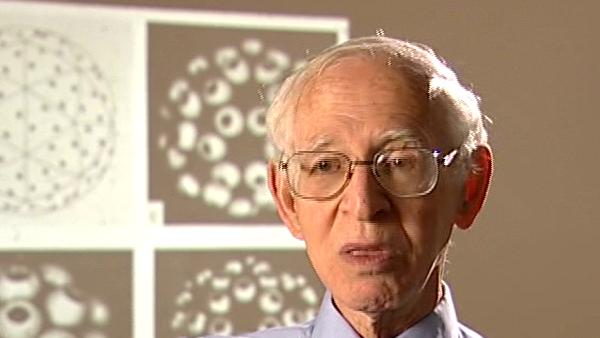We now know what Rosalind didn't know – that they had seen the MRC report in 1952. But to this day I don't know whether she... how much she knew of what they... she must have suspected that Crick and Watson must have known a good deal about her work but none of it was published other than the MRC report. But I don't know that she knew that they had read this report, it was supposed to be... well, it wasn't confidential it was... it was meant to be only for MRC units. So I don't want to go into the whole story, I've written about this, as you know, on the 50th anniversary. But I think the... the degree of confidentiality is in dispute but there's no question that apart from Maurice Wilkins showing Jim Watson, Rosalind Franklin's photograph, which made his eyes open, and which he hadn't seen before, there was also the MRC report circulated by MRC units which gave the critical dimensions which they could deduce the diameter of the helices and gave all the... so between that they had all the information to build the model. But... so, Watson's book, this only came out when Jim Watson published his book, The Double Helix. You know the original was going to be called Honest Jim, he's telling the truth, but that's a play on Lucky Jim Kingsley Amis, one of the novels at the time. So the... he... well, what should have happened though, when they wrote their paper in 1954 on the... how they arrived at the double helix, with the base paring, of course, Watson got the base paring, there's no question about that. But the fact is that the framework the... the double helix structure was based by Crick understanding, the implications of the space group symmetry that Franklin described. There's no... now, what they should have done, they should have, when they wrote the paper, is to acknowledge this, it wouldn't have diminished their achievement to do it. And I discussed this with both Crick and Watson; Jim, Jim Watson says, 'Ah, I didn't say... describe the C2 monoclinic symmetry because I didn't use it, and that's true.' He didn't use it explicitly but the fact is that Francis did when he built the double; he built the two chain double helix with the chains in opposite directions. And he did that, and it was that that enabled Watson to put his base pairs into the double helix. So there's no question that Rosalind should have been cited and should have been cited. And I... so, I've discussed this with both of them. Francis thought that it was in the paper, and he thought that they had mentioned it. He says he didn't deliberately not mention it, but Jim wrote part of that paper, it's hard to say who wrote what. I can detect, I know their styles, I can detect bits of both but, then, of course, they both worked and re-wrote it. But this long controversy is, well... we talk about Rosalind and DNA, what she told me, and I've described this in my papers, she said, 'I could have kicked myself', those were her exact words to me. 'I could have kicked myself not... for not realising that the two fold symmetry applied to... to the... to the A form as well as to the B form, to the B form as well as the A form.' And so, you see, the irony of it all is that Franklin, Wilkins and Stokes, all the three people at Kings had all been to lectures in Cambridge, they were all Cambridge graduates, and they'd all been to the Bernal's lectures in crystallography. And they actually were lectured on space groups, but, of course, this was all very abstract. The only person who understood the implication of the C2 monoclinic symmetry was Francis Crick, who hadn't done any form of crystallography but he had taught himself on the job, so to speak, and he became a Research student of Perutz. But Rosalind never complained, never, I never heard her complain, or whinge or anything about it, I think she regarded herself as... as, in fact, she admired them enormously, both of them.





